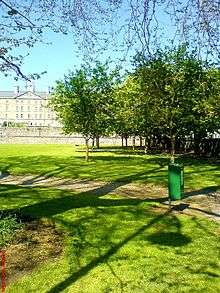Croppies' Acre
The Croppies' Acre (Irish: Acra na gCraipithe[1]), officially the Croppies Acre Memorial Park, is a public park in Dublin, Ireland. It contains a memorial to the dead of the 1798 Rebellion.[2][3][4]
| Croppies' Acre | |
|---|---|
.jpg) The Croppies' Acre, with Collins Barracks behind. | |
 Croppies' Acre | |
| Type | Municipal |
| Location | Wolfe Tone Quay, Dublin 7 |
| OSI/OSNI grid | O 141 344 |
| Coordinates | 53.347464°N 6.287136°W |
| Area | 1.8 hectares (4.4 acres) |
| Operated by | Dublin City Council |
| Status | Open all year |

History
The site, located on the north bank of the River Liffey to the south of Collins Barracks (formerly the Royal Barracks) is traditionally believed to have been used as a mass grave for Irish rebel casualties of the 1798 Rebellion; they were known as Croppies due to their short-cropped hair. It was also called Croppies' Hole at the time.[5][6] Some rebels' bodies were also exhibited at the Croppies' Hole, tied to pikes.[7]
The National Graves Association maintains that it was also used after 1798 to bury veterans of the conflict, including Matthew Tone, brother of Wolfe Tone.[8] Bartholomew Teeling was also supposedly buried at Croppies' Acre after being hanged at Provost Prison, Arbour Hill.[9] However, archaeological investigations have failed to find any human remains and its status as a grave is uncertain.[10][11] The precise site of the burials was long disputed, all being known was that the dead had been buried on marshy ground near the Royal Barracks. In addition, the River Liffey was realigned in this area to extend the city's quays. The supposed "Croppies' Acre" was for a long time a soldiers' playing field.[12]
The Memorial Park was designed and laid out in 1998.
It was closed in 2012 by the OPW due to anti-social behaviour, including heroin addicts leaving used syringes behind. Ownership was transferred to Dublin City Council and the Croppies' Acre was reopened in 2016.[13]
See Also
References
- "Acra na gCraipithe/Croppies' Acre". Logainm.ie.
- Collins, Peter (28 January 2019). "Who Fears to Speak of '98'?: Commemoration and the Continuing Impact of the United Irishmen". Ulster Historical Foundation – via Google Books.
- Beiner, Guy (18 October 2018). "Forgetful Remembrance: Social Forgetting and Vernacular Historiography of a Rebellion in Ulster". Oxford University Press – via Google Books.
- Collins, James T. (28 January 1978). "Life in Old Dublin". Tower Books – via Google Books.
- "Selection of Reports and Papers of the House of Commons: State of Ireland ; [1]". 28 January 2019 – via Google Books.
- Collins, James T. (28 January 1978). "Life in Old Dublin". Tower Books – via Google Books.
- Forché, Carolyn; Wu, Duncan (27 January 2014). "Poetry of Witness: The Tradition in English, 1500-2001". W. W. Norton & Company – via Google Books.
- Fitzgerald, Cormac. "1798 Rebellion memorial park that closed due to anti-social behaviour will reopen today". TheJournal.ie.
- "A shocking picture from the Croppies Acre memorial". 11 October 2013.
- AM, Laura Larkin-08 June 2016 02:30. "DCC report places question mark over Croppies Acre 'burial ground'". Herald.ie.
- Falvey, Deirdre. "National Museum to unveil plans for major revamp". The Irish Times.
- McNally, Frank (28 January 2019). "111 Places in Dublin that you must not miss". Emons Verlag – via Google Books.
- "Croppies stand up - An Irishman's Diary about reclaiming a Dublin park". The Irish Times.